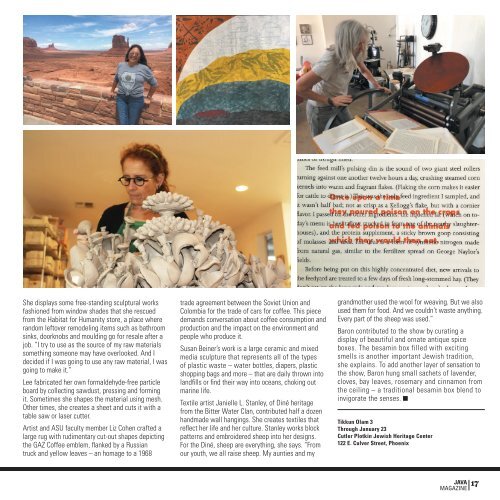JAVA Dec '18 issue
You also want an ePaper? Increase the reach of your titles
YUMPU automatically turns print PDFs into web optimized ePapers that Google loves.
She displays some free-standing sculptural works<br />
fashioned from window shades that she rescued<br />
from the Habitat for Humanity store, a place where<br />
random leftover remodeling items such as bathroom<br />
sinks, doorknobs and moulding go for resale after a<br />
job. “I try to use as the source of my raw materials<br />
something someone may have overlooked. And I<br />
decided if I was going to use any raw material, I was<br />
going to make it.”<br />
Lee fabricated her own formaldehyde-free particle<br />
board by collecting sawdust, pressing and forming<br />
it. Sometimes she shapes the material using mesh.<br />
Other times, she creates a sheet and cuts it with a<br />
table saw or laser cutter.<br />
Artist and ASU faculty member Liz Cohen crafted a<br />
large rug with rudimentary cut-out shapes depicting<br />
the GAZ Coffee emblem, flanked by a Russian<br />
truck and yellow leaves – an homage to a 1968<br />
trade agreement between the Soviet Union and<br />
Colombia for the trade of cars for coffee. This piece<br />
demands conversation about coffee consumption and<br />
production and the impact on the environment and<br />
people who produce it.<br />
Susan Beiner’s work is a large ceramic and mixed<br />
media sculpture that represents all of the types<br />
of plastic waste – water bottles, diapers, plastic<br />
shopping bags and more – that are daily thrown into<br />
landfills or find their way into oceans, choking out<br />
marine life.<br />
Textile artist Janielle L. Stanley, of Diné heritage<br />
from the Bitter Water Clan, contributed half a dozen<br />
handmade wall hangings. She creates textiles that<br />
reflect her life and her culture. Stanley works block<br />
patterns and embroidered sheep into her designs.<br />
For the Diné, sheep are everything, she says. “From<br />
our youth, we all raise sheep. My aunties and my<br />
grandmother used the wool for weaving. But we also<br />
used them for food. And we couldn’t waste anything.<br />
Every part of the sheep was used.”<br />
Baron contributed to the show by curating a<br />
display of beautiful and ornate antique spice<br />
boxes. The besamin box filled with exciting<br />
smells is another important Jewish tradition,<br />
she explains. To add another layer of sensation to<br />
the show, Baron hung small sachets of lavender,<br />
cloves, bay leaves, rosemary and cinnamon from<br />
the ceiling – a traditional besamin box blend to<br />
invigorate the senses.<br />
Tikkun Olam 3<br />
Through January 23<br />
Cutler Plotkin Jewish Heritage Center<br />
122 E. Culver Street, Phoenix<br />
<strong>JAVA</strong> 17<br />
MAGAZINE

















